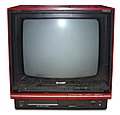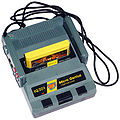History of video games/Platforms/Nintendo Entertainment System
-
The iconic Japanese Famicom and controllers.
-
The iconic North American NES and controller.
History
[edit | edit source]Development
[edit | edit source]Famicom Development
[edit | edit source]The Famicom, and by extension the Nintendo Entertainment System, was proceeded by the Color TV-Game Series. Development was lead by noted engineer Masayuki Uemura,[1][2] who was asked to develop a new more competitive and advanced home gaming system by Nintendo President Hiroshi Yamauchi during a phone call to the Uemura house.[3] This was part of a larger strategy in which Hiroshi Yamauchi decided to reinvest profits from the Color TV Game and Game and watch systems into further game products.[4]
Plans for the system originally called for a 16-bit CPU but a more economical 8-bit CPU was chosen.[5][6] Nintendo was able to further optimize the cost of the CPU by placing a very large bulk order with Ricoh,[7] who had an underutilized factory at the time.[8] This technical choice had an additional unexpected effect of attracting developer Satoru Iwata to the system, who would later become a key developer at Nintendo, and later serve as its president.[9]
NES Development
[edit | edit source]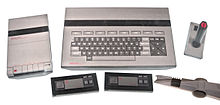
In 1983 Nintendo approached Atari about releasing their console in the USA, and agreed on it until a misunderstanding at CES 1983 sunk the deal.[10]
Designer Lance Barr was charged with refining the design of the NES to make it appealing to American audiences while keeping costs low,[11] ultimately creating an iconic design.
Nintendo would attempt to make an user avatar system for the console, but this would ultimately be scrapped and shelved until the release of Miis on the Nintendo Wii decades later.[12][13]
Launch
[edit | edit source]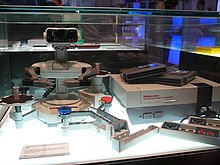
Now you're Playing with Power!—NES Slogan, [14]
The Family Computer (Famicom) was released in Japan on July 15, 1983 at a cost of 14,800 yen.[4][15] Nintendo later released the similar Nintendo Entertainment System (NES) to international markets. The NES saw its American release in 1985, and European release in 1986.[16][15] In the United States the NES was a dominant player in the market,[17] and was so popular that it began to alter how people discussed gaming, with many people using the word "Nintendo" to describe video games in general for a time, even those not made by Nintendo.[18][19] Fearing the word "Nintendo" might become a generic trademark, Nintendo promoted the word "Game Console" instead.[20]
Internationally the NES received significant challenges from the Sega Master System particularly in South America and Europe.[17]
1983 also saw the launch of the Sharp Game Television (Also known as the Sharp Nintendo Television or as the Sharp C1 NES TV) which integrated a Famicom with a 19 inch TV costing 145,000 yen or a 14 inch TV that cost 93,000 yen.[21]
Seal of Quality
[edit | edit source]To avoid negative associations with video game consoles following the video game crash of 1983, Nintendo used careful wording in its marketing to brand the NES as an "Entertainment" system, rather then a game console.[17] To avoid a repeat of the poor quality games that caused the crash, Nintendo required licensed developers to limit game releases to two a year, as well as to censor overt depictions of gore and other sensitive subjects.[17] These policies were a cause of friction between some developers and Nintendo.[22]
Later on in the system life, an Atari subsidiary would break the lockout protection used to enforce Nintendo's licensing, though this resulted in legal challenges.[23] This inspired other companies to make their own bypass, though methods that used a charge pump or negative voltage spike could damage the system.[23][24]
Smash hit
[edit | edit source]The NES had a limited United States of America launch in New York City and Los Angeles October 15th, 1985, with a nationwide release a year later.[25][26] These first markets were picked to see if the NES could survive in difficult markets, and retailers were persuaded to carry the system by only needing to pay for systems sold, with unsold stock being fully returnable.[26] The 1989 television show Captain N was used to promote Nintendo products.[27]
The Famicom Tiler was jointly launched by Nintendo and Sharp in 1989 at a cost of 43,000 yen, and added video editing features and S-Video to improve screen captures for media outlets.[28]
International Adoption
[edit | edit source]Some regions such as India saw officially licensed versions of the NES released under other names.[29][30][31]
Other clones were unlicensed, like the Dendy console, made in Taiwan for the newly accessible Russian market where it was legal due to a lack of Intellectual property laws at the time.[32] This later led to an official partnership between Dendy and Nintendo.[32][33]
NES 101
[edit | edit source]In 1993 the NES 101, a cost reduced version of the NES was released, removing the composite output and lowering the price to $49.99.[34]
Legacy
[edit | edit source]61.91 million NES and Famicom consoles were sold.[35][36]
The Nintendo Entertainment System and the Famicom was succeeded by the Super Nintendo Entertainment System and the Super Famicom.
Nintendo stopped producing new NES units in 1995, new Famicom systems in 2003, and stopped repairing Famicom systems in 2007.[17]
Technology
[edit | edit source]Compute
[edit | edit source]The NES CPU was a reduced feature version of the MOS 6502, a Rioch 2A03.[37] The CPU was clocked at 1.789773Mhz in NTSC regions, and at 1.773447Mhz in PAL regions.[37]
The NES had two kilobytes of RAM and two kilobytes of video RAM.[37][38]
Graphics
[edit | edit source]The NES had a Rioch 2C02 Picture Processing Unit (PPU) for graphical output, supporting up to 52 colors and 64 sprites.[37] The PPU was clocked at 5.37 megahertz.[39] The PPU had 256 bytes of memory located directly on chip, which was known as Object Attribute Memory.[39] The PPU had a number of limitations on what it could do simultaniously, notably limiting sprites to use only 3 colors at a time, with an additional transparency color.[39][40] However, clever programmers and artists often found ways to lean into or even subvert these limitations through guile and wit. The PPU of the NES was quite capable for it's time, and gave the system a graphical edge over much of it's competition.
Audio
[edit | edit source] |
|
| Problems listening to this file? See media help. | |
The Nintendo Entertainment System had 2 pulse wave channels, 1 triangle wave channel, 1 noise channel, and 1 DPCM channel.[37] Games for the Famicom often featured much better audio then on the Nintendo Entertainment System, as the Famicom has additional pins for cartridge based sound chips.[41] A number of different additional audio chips were used in Famicom cartridges.[42]
Controllers
[edit | edit source]NES Hands Free Controller
[edit | edit source]Nintendo of America developed a hands free controller for disabled gamers, among the earliest of it's kind.[43] A chin mounted joystick and breath tube served as input.[43] The controller was chest mounted and weighed 2.5 pounds (1.1 kg).[44] A prototype was tested at the Children's Orthopedic Hospital in Seattle, Washington,[44] near where Nintendo of America was headquartered.
Notable Games
[edit | edit source]
Dates are for the earliest release on the Famicom or NES. International releases often occurred one or two years later. |
1983
[edit | edit source]Mario Bros.
[edit | edit source]A recreation of the arcade game.
Read more about Mario Bros. on Wikipedia.
1984
[edit | edit source]1985
[edit | edit source]Super Mario Bros
[edit | edit source]First version of Mario as an adventure platformer.
From here on, designers Shigeru Miyamoto, Takashi Tezuka, developer Toshihiko Nakago and musician Koji Kondo would typically work together as a unit on future projects, to great success.[45]
Read more about Super Mario Bros 1 on Wikipedia.
Wrecking Crew
[edit | edit source]An early Mario puzzle-platformer.
Read more about Wrecking Crew on Wikipedia.
1986
[edit | edit source]- Dragon Quest - Popular RPG
- Kid Icarus
- Ghosts 'n Goblins
The Legend of Zelda
[edit | edit source]
The Legend of Zelda is one of the most iconic Famicom and NES games, mainly because of the expansive multimedia franchise it started. Sigeru Miyamoto was inspired to make this game by his personal experience of exploring the countryside and caves as a child.[46]
Metroid
[edit | edit source]Metroid is noted for being an early game with a female protagonist.[47]
Read more about Metroid on Wikipedia.
1987
[edit | edit source]- Zelda II: The Adventure of Link - 2D scroller adaptation of the Zelda format.
- Mega Man - Known as Rockman in Japanese markets.
- Rad Racer
- Punch-Out!!
- Nakayama Miho no Tokimeki High School
Final Fantasy
[edit | edit source]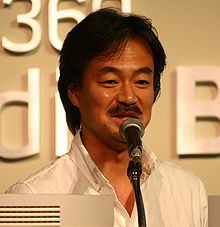
The first game in the popular RPG series.
The game was named Final Fantasy because the developers thought it would be their final game before Square went bankrupt.[48]
Many elements of Final Fantasy appear to be inspired by Advanced Dungeons and Dragons.[49][50]
Read more about Final Fantasy I on Wikipedia.
Metal Gear
[edit | edit source]Early popular stealth game.
The NES port of Metal Gear was made without the involvement of Hideo Kojima, who disliked the NES version.[51]
Read more about Metal Gear on Wikipedia.
1988
[edit | edit source]- Super Mario Bros. 2 - Remake of the Japanese game Doki Doki Panic.
- Super Mario Bros. 3
- Mega Man 2 - The best selling Mega Man game.[52]
- Contra
- Ninja Gaiden
Famicom Detective Club The Missing Heir Volumes 1 and 2
[edit | edit source]
An Japan only primeval visual novel that notably strayed from adventure game conventions to make a more story focused game.[53]
Character Ayumi Tachibana would later be considered as a Super Smash Brothers Melee character.[54][55]
Read more about the Famicom Detective Club series on Wikipedia.
1989
[edit | edit source]- Teenage Mutant Ninja Turtles
- Mendel Palace / Quinty
- A Boy and His Blob: Trouble on Blobolonia
- Faria: A World of Mystery and Danger!
Mother
[edit | edit source]The first game in the Mother series.
A documentary was produced about an unreleased prototype english cartridge.[56]
Read more about Mother on Wikipedia.
Tetris
[edit | edit source]Popular game from the Soviet Union, licensed to Nintendo for home consoles in the west.
In 2021 a new technique for the NES version of the game was discovered where pressure was applied to the back of the controller to allow for faster inputs, allowing world records to be broken.[57][58]
Read more about Tetris on Wikipedia.
Famicom Detective Club The Girl Who Stands Behind Volumes 1 and 2
[edit | edit source]The second entry in the then Japan exclusive Famicom Detective Club series.[53] Series director Yoshio Sakamoto was able to better work around system limitations to his satisfaction in this entry.[53]
Read more about the Famicom Detective Club series on Wikipedia.
1990
[edit | edit source]Final Fantasy III
[edit | edit source]Not to be confused with the North American Final Fantasy III for the SNES, which was Final Fantasy VI in other regions but had its name changed in North America to avoid skipping missed releases.[59] This was done to avoid confusion at the time, though it caused some confusion later.[59]
Final Fantasy III was the first Final Fantasy series game to break a million sales.[60]
Read more about Final Fantasy III on Wikipedia.
1991
[edit | edit source]1993
[edit | edit source]Kirby's Adventure
[edit | edit source]The second game in the Kirby series. It introduced a mechanic allowing the player to copy enemy abilities,[61] becoming a series staple from there onward.
The game is considered by many to be make good use of the technical capabilities of the NES, having good graphics given the system limitations.[62]
Read more about Kirby's Adventure on Wikipedia.
Gallery
[edit | edit source]Famicom
[edit | edit source]NES
[edit | edit source]NES 101
[edit | edit source]AV Famicom
[edit | edit source]Sharp Twin Famicom
[edit | edit source]Other Console Variants
[edit | edit source]Controllers
[edit | edit source]Accessories
[edit | edit source]Games
[edit | edit source]Motherboards
[edit | edit source]Development
[edit | edit source]Marketing
[edit | edit source]-
Family Computer (Famicom) logo.
-
Nintendo Entertainment System (NES) logo.
Clone Consoles
[edit | edit source]Trivia
[edit | edit source]A third party company, Power 10 Inc., made a early motion controller for the NES that used mercury switches called the Hot Stik.[63]
Further reading
[edit | edit source]There is a WikiBook on NES programming.
External Resources
[edit | edit source]- Video Game Console Library - Famicom/NES page.
- Nintendo UK Blog - Post showing design documents for the original Legend of Zelda.
References
[edit | edit source]| Parts of this page are based on materials from: Wikipedia: the free encyclopedia. |
- ↑ "「ファミコン」生みの親・上村雅之さん死去 78歳|秋田魁新報電子版" (in ja). 秋田魁新報電子版. https://www.sakigake.jp/news/article/20211209OR0114/?nv=ent.
- ↑ "Masayuki Uemura, Creator Of The NES And SNES, Dies At 78" (in en-us). Kotaku. https://kotaku.com/masayuki-uemura-creator-of-the-nes-and-snes-dies-at-7-1848184264.
- ↑ "Iwata Asks". iwataasks.nintendo.com. https://iwataasks.nintendo.com/interviews/#/wii/mario25th/1/0.
- ↑ a b Hongo, Jun (15 July 2013). "Nintendo brought arcade games into homes 30 years ago". The Japan Times. https://www.japantimes.co.jp/news/2013/07/15/reference/nintendo-brought-arcade-games-into-homes-30-years-ago/. Retrieved 25 October 2020.
- ↑ "NintendoLand - The best site for info about Nintendo's classic video games.". web.archive.org. 25 May 2009. https://web.archive.org/web/20090525223925/http://www.nintendoland.com/home2.htm?nes%2Fhistory.htm.
- ↑ "NES". scf.usc.edu. Retrieved 7 December 2020.
- ↑ Arsenault, Dominic. Super Power, Spoony Bards, and Silverware: The Super Nintendo Entertainment System. MIT Press. ISBN 978-0-262-34150-9. Retrieved 20 December 2020.
- ↑ "Iwata Asks". iwataasks.nintendo.com. https://iwataasks.nintendo.com/interviews/#/wii/mario25th/1/1.
- ↑ Lane, Gavin (9 December 2021). "Masayuki Uemura, The Nintendo Engineer Who Helped Define The Modern Games Console". Nintendo Life. https://www.nintendolife.com/features/masayuki-uemura-the-nintendo-engineer-who-helped-define-the-modern-games-console.
- ↑ "Feature: Remember When Atari Turned Down Nintendo And Sega?". Nintendo Life. 3 February 2020. https://www.nintendolife.com/news/2020/02/feature_remember_when_atari_turned_down_nintendo_and_sega. Retrieved 23 October 2020.
- ↑ "Lance Barr Interview". nintendojo ~ a site to see. 13 February 2006. https://web.archive.org/web/20060213124455/http://www.nintendojo.com/interviews/view_item.php?1130801472.
- ↑ "GDC: Miyamoto Keynote Extend Extra" (in en-us). Wired. https://www.wired.com/2007/03/gdc-miyamoto-ke/.
- ↑ "Why Nintendo is Bringing Back Miis". Retrieved 1 March 2021.
- ↑ Koch, Cameron (21 July 2016). "Nintendo Brings Back Retro 'Now You're Playing With Power' Slogan For New NES Classic Edition Ad" (in en). Tech Times. https://www.techtimes.com/articles/170917/20160721/nintendo-brings-back-retro-now-youre-playing-with-power-slogan-for-new-nes-classic-edition-ad.htm.
- ↑ a b Sottek, T. C. (15 July 2013). "The Nintendo Famicom turns 30 years old today" (in en). The Verge. https://www.theverge.com/2013/7/15/4524758/NES-famicom-30-year-anniversary. Retrieved 19 October 2020.
- ↑ "Nintendo Entertainment System Video Game Console". Smithsonian Institution. Retrieved 18 October 2020.
- ↑ a b c d e Cunningham, Andrew (15 July 2013). "The NES turns 30: How it began, worked, and saved an industry" (in en-us). Ars Technica. https://arstechnica.com/gaming/2013/07/time-to-feel-old-inside-the-nes-on-its-30th-birthday/. Retrieved 19 October 2020.
- ↑ Ward, Cassidy (5 June 2019). "Science Behind the Fiction: How Nintendo saved and redefined the game industry". SYFY WIRE. Retrieved 20 January 2021.
- ↑ "Why old people call my Playstation 4..... "nintendo"? - PlayStation 4". gamefaqs.gamespot.com. Retrieved 20 January 2021.
- ↑ "'Genericide': When brands get too big" (in en). The Independent. 18 January 2019. https://www.independent.co.uk/news/business/analysis-and-features/genericide-when-brands-get-too-big-2295428.html.
- ↑ "This Nintendo Was Inside A Television Set" (in en-us). Kotaku. https://kotaku.com/this-nintendo-was-inside-a-television-set-5787855. Retrieved 27 October 2020.
- ↑ "The Untold Story of Maniac Mansion". Wierd (Magazine-1.04). 04/01/1993. https://www.wired.com/1993/04/nintendo-2/.
- ↑ a b "That Time Atari Cracked The Nintendo Entertainment System". Hackaday. 22 October 2018. https://hackaday.com/2018/10/22/that-time-atari-cracked-the-nintendo-entertainment-system/#more-329497. Retrieved 25 October 2020.
- ↑ "How Third-Party Game Devs Reverse-Engineered Their Way Onto Your Consoles (and Into Your Heart)". www.vice.com. Retrieved 28 November 2020.
- ↑ "The NES Was Once So Rare You Could Only Get It In Two Cities" (in en-us). Kotaku. https://kotaku.com/the-nes-was-once-so-rare-you-could-only-get-it-in-two-c-1686643953. Retrieved 27 October 2020.
- ↑ a b "Oct. 18, 1985: Nintendo Entertainment System Launches" (in en-us). Wired. https://www.wired.com/2010/10/1018nintendo-nes-launches/. Retrieved 27 October 2020.
- ↑ Weber, Rachel (3 March 2017). "Flashback: Nintendo's Gamer Cartoon 'Captain N: The Game Master'". Rolling Stone. https://www.rollingstone.com/culture/culture-news/flashback-nintendo-entertains-gamers-with-captain-n-the-game-master-cartoon-124904/.
- ↑ "The Nintendo Console From The 80s Made For Recording Gameplay Footage" (in en-us). Kotaku. https://kotaku.com/the-nintendo-console-from-the-80s-that-could-record-gam-1739086864. Retrieved 27 October 2020.
- ↑ Patil, Siddharth (12 May 2016). "Nintendo And India :: A complicated Love Story". Gameffine. Retrieved 10 December 2020.
- ↑ Ghoshal, Abhimanyu (30 December 2017). "Why has Nintendo ignored India for 30 years?". The Next Web. Retrieved 10 December 2020.
- ↑ "The NES Samurai boxed!". Consolevariations. Retrieved 10 December 2020.
- ↑ a b Calvin, Alex (17 December 2017). "How a counterfeit NES console opened up the Russian games market". Eurogamer. Retrieved 10 December 2020.
- ↑ Muradov, Roman (23 October 2017). "Dendy's Dream Debased". Medium. Retrieved 10 December 2020.
- ↑ Byford, Sam (11 July 2019). "A brief history of cutdown game consoles" (in en). The Verge. https://www.theverge.com/circuitbreaker/2019/7/11/20690011/nintendo-switch-lite-game-console-redesign-xbox-playstation. Retrieved 19 October 2020.
- ↑ "Genesis vs. SNES: By the Numbers - IGN". Retrieved 13 November 2020.
- ↑ "IR Information : Sales Data - Dedicated Video Game Sales Units". Nintendo Co., Ltd. Retrieved 14 November 2020.
- ↑ a b c d e "NES Programming - Wikibooks, open books for an open world". en.wikibooks.org. Retrieved 25 October 2020.
- ↑ "Nintendo Family Computer (Famicom) Teardown". iFixit. 1 July 2010. Retrieved 29 October 2020.
- ↑ a b c Cunningham, Andrew (9 December 2021). "The NES: How it began, worked, and saved an industry" (in en-us). Ars Technica. https://arstechnica.com/gaming/2021/12/time-to-feel-old-inside-the-nes-on-its-30th-birthday/.
- ↑ "How The NES Displayed Large Enemies". The Fantasy Console Club (Pixel Vision 8). 9 June 2020. https://pixelvision8.substack.com/p/how-the-nes-displayed-large-enemies-7007aa5acfd5.
- ↑ "Famicom vs NES". 1 More Castle. 16 May 2014. Retrieved 7 December 2020.
- ↑ "Nerdly Pleasures: Famicom Expansion Audio Overview". Nerdly Pleasures. 4 August 2017. Retrieved 7 December 2020.
- ↑ a b "Nintendo Made a Disability Friendly NES controller in the 80's - Access-Ability". Retrieved 11 October 2021.
- ↑ a b "Now you're playing with ... no hands". Engadget. https://www.engadget.com/2007-05-23-now-youre-playing-with-no-hands.html.
- ↑ Davison, John (12 December 2016). "Shigeru Miyamoto on Mario, 'Minecraft' and Working With Apple". Rolling Stone. https://www.rollingstone.com/culture/culture-news/shigeru-miyamoto-on-mario-minecraft-and-working-with-apple-106277/.
- ↑ Sheff, David; Sheff, David (9 January 1992). "Mario's Big Brother: Sigeru Miyamoto". Rolling Stone. https://www.rollingstone.com/culture/culture-news/marios-big-brother-sigeru-miyamoto-198593/.
- ↑ Tappin, Steve (5 August 2016). "30 years of Samus Aran: a feminist icon?". BBC Three. https://www.bbc.co.uk/bbcthree/article/39a1b88f-79dc-4602-8207-f86918afd457.
- ↑ "Why's It Called 'Final Fantasy'? Uematsu Explains". Wired. Retrieved 2 November 2020.
- ↑ "Dungeons & Dragons Classes Inspired The Final Fantasy Jobs". ScreenRant. 16 July 2020. Retrieved 2 November 2020.
- ↑ "» Discussion: Final Fantasy's D&D Origins". Retrieved 2 November 2020.
- ↑ "Turns Out Hideo Kojima HATES Metal Gear On the NES". Kotaku. Retrieved 8 November 2020.
- ↑ "Mega Man 11 Now Third Best-Selling Game In The Franchise At 1.3 Million Units Sold". NintendoSoup. 12 November 2020. https://nintendosoup.com/mega-man-11-now-third-best-selling-game-in-the-franchise-at-1-3-million-units-sold/.
- ↑ a b c "Before visual novels, ’Famicom Detective Club’ writer recalls the genre’s limitations". Washington Post. https://www.washingtonpost.com/video-games/2021/05/26/famicom-detective-club-yoshio-sakamoto/.
- ↑ "Famicom Detective Club: One of the first visual novel series resurrected on Switch". App Trigger. 2021-05-16. https://apptrigger.com/2021/05/16/famicom-detective-club-switch/.
- ↑ Gordon, Justin (2021-05-05). "A character from Famicom Detective Club was briefly considered as a character on the roster by Masahiro Sakurai for Super Smash Bros. Melee" (in en). EventHubs. https://www.eventhubs.com/news/2021/may/05/famicom-detective-sakurai-roster-ssbm/.
- ↑ Mattise, Nathan (14 March 2021). "Mother to Earth: When an NES prototype lands on eBay and inspires a documentary" (in en-us). Ars Technica. https://arstechnica.com/gaming/2021/03/mother-to-earth-when-an-nes-prototype-lands-on-ebay-and-inspires-a-documentary/.
- ↑ "NES Tetris Players Are Using a Special Technique Called Rolling to Set New World Records - IGN" (in en). https://www.ign.com/articles/tetris-players-are-using-a-special-technique-called-rolling-to-set-new-world-records.
- ↑ "NES Tetris Players Call It 'Rolling,' And They're Setting New World Records" (in en-us). Kotaku. https://kotaku.com/nes-tetris-players-call-it-rolling-and-theyre-setting-1846767518.
- ↑ a b Statt, Nick (26 June 2017). "Nintendo's SNES Classic has a confusingly named Final Fantasy game". The Verge. Retrieved 25 November 2020.
- ↑ "FINAL FANTASY III - new patch released today Square Enix Blog". square-enix-games.com. Retrieved 25 November 2020.
- ↑ "Kirby: 10 Copy Abilities You Forgot Existed". TheGamer. 10 March 2020. https://www.thegamer.com/kirby-copy-abilities-forgot-existed/.
- ↑ "Review: Kirby's Adventure (Wii Virtual Console / NES)". Nintendo Life. 13 February 2007. https://www.nintendolife.com/reviews/nes/kirbys_adventure.
- ↑ "The Original NES Console Had a Motion Control Joystick 15 Years Before the Nintendo Wii Did" (in en-us). Gizmodo. https://gizmodo.com/the-original-nes-console-had-a-motion-control-joystick-1835626330. Retrieved 25 October 2020.

















